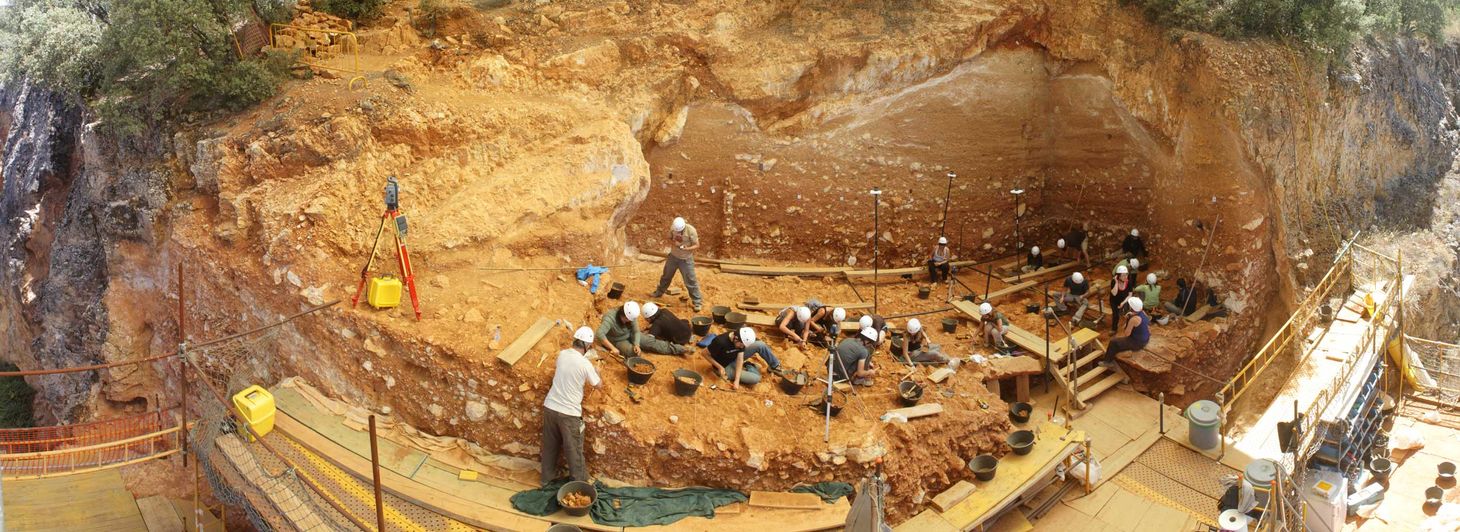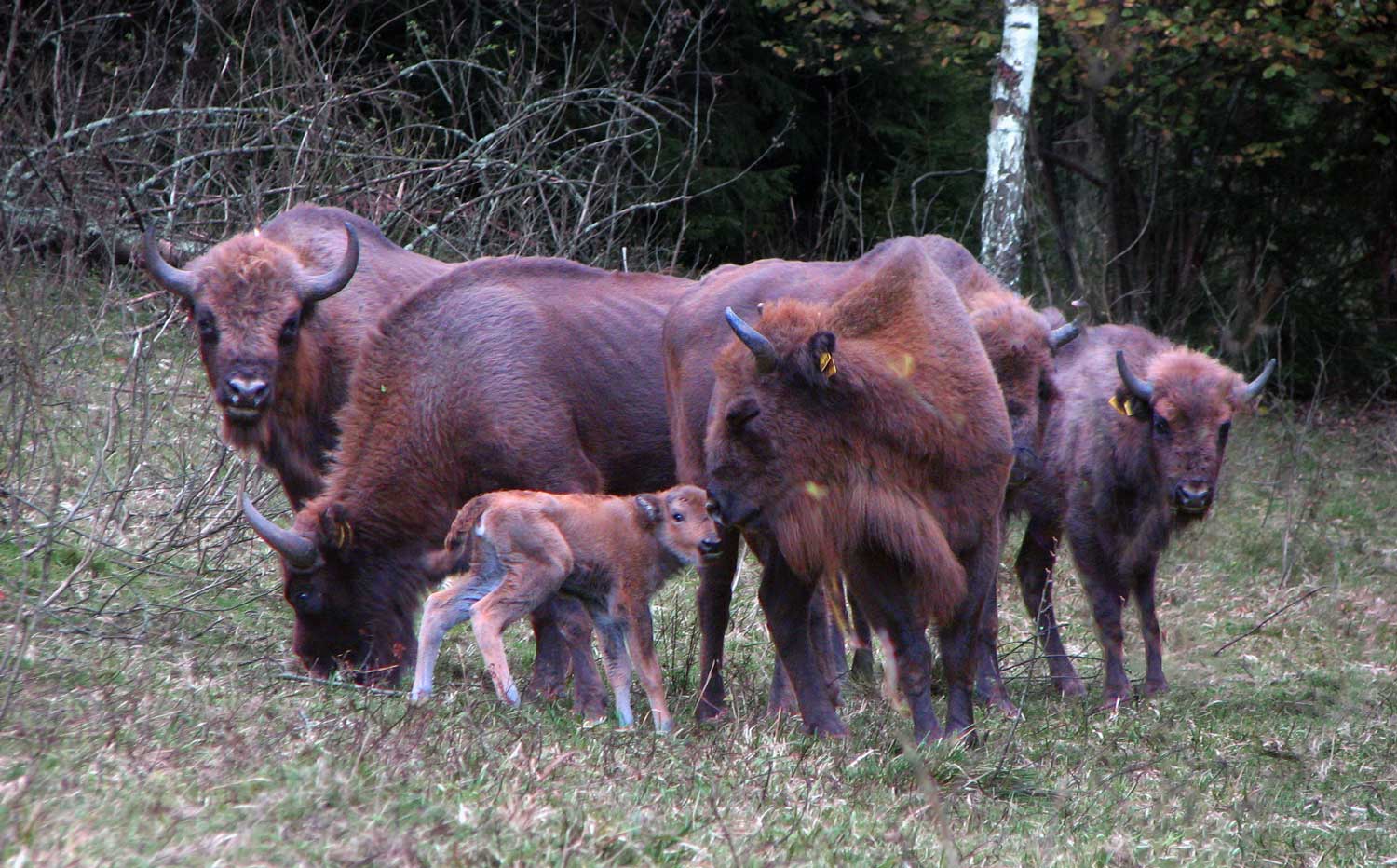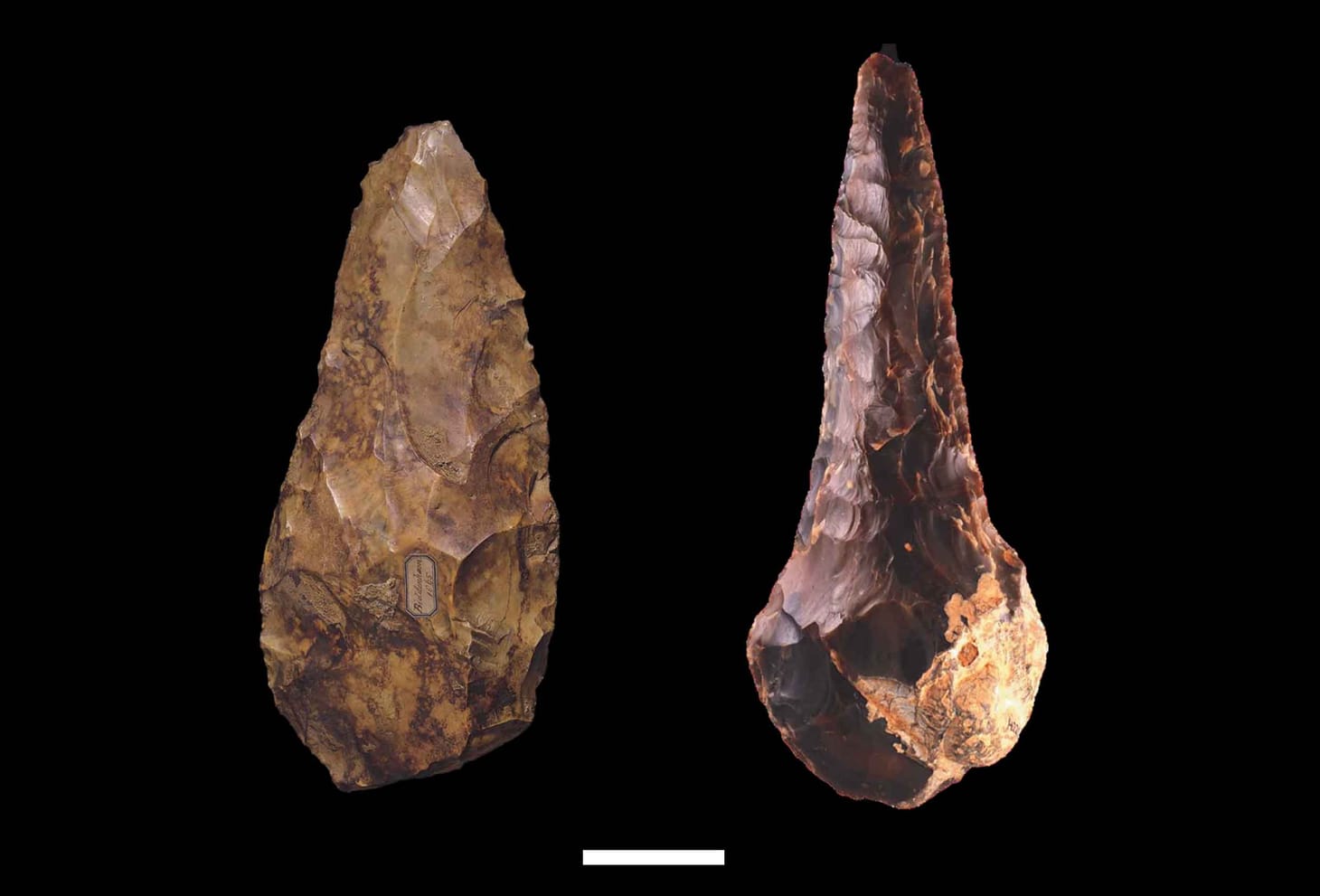Bison bones show butchery practices 400,000 years ago
In the Gran Dolina cave site, ancient people left a bone bed of bison killed in two seasons and butchered at the site with expedient tools.

The site of Gran Dolina, Spain, was once a large underground cave. The deposits of bone and sediment that formed inside the cave more than 700,000 years ago preserve the fossils of Homo antecessor, a species that paleoanthropologists have identified only from this site.
Then the cave entrances that H. antecessor had used for more than a hundred thousand years were closed off.
The record picks up again sometime after 450,000 years ago, when the cave once again opened from above. Over the following 200,000 years, the cave was more and more exposed to the surface of the Sierra de Atapuerca. Ancient people used the cave during this later period of time, and the sediment contains thousands of stone implements and the bones of animals that they ate. These materials make up layer TD10, divided into four levels numbered from TD10.4 up to TD 10.1.
There are no identifiable hominin bones or teeth from this later Gran Dolina sequence. The large sample of early Neandertal remains from the nearby Sima de los Huesos dates to around 430,000 years ago, and it seems likely that a similar population may have been responsible for TD10. But I don't write this without caveats. Other hominin populations may have existed in Europe during this period of time, and even if some might be identified as Neandertals that does not mean they were culturally or physically the same as the Sima population. Over thousands of years even a single level at Gran Dolina may represent the behavior of genetically diverse hominin groups.
Midway through the TD10 sequence, archaeologists uncovered a bone bed made up of more than 45,000 bone fragments. Specialists in zooarchaeology could identify around half the fragments, 98% of which came from bison. This bison bone bed includes the remains of more than 60 bison individuals from around 400,000 years ago.
Antonio Rodríguez-Hidalgo and colleagues summarized the information from these bison remains in a 2017 research article. They discussed earlier work in which they established the approximate ages of the bison from their dental remains. They also examined the pattern of preserved elements across the skeleton. They found cutmarks and tooth marks, and looked the the way the bones were fragmented.
From this, they could reconstruct some of the actions of the ancient people at the site.

The hunters carried whole bison bodies into Gran Dolina. There they butchered the animals further and then carried most of the long bones somewhere else. What they left behind was mostly skulls, vertebrae, and ribs—many more ribs than most other faunal assemblages. The hominins paused as they butchered the carcasses to break the ribs and “snack” on red bone marrow. Cutmarks on the internal surfaces of mandibles and on hyoid bones show that they removed and ate many of the tongues.
People left tooth marks on some of the hyoids. Tooth marks from ancient people are also common on the ribs, many of those bones also cutmarked. The people used their teeth to peel connective tissue from these bones.
Many of the bison were young juvenile individuals. This enabled the researchers to look at the seasonality of the kills. Across the first year of a bison's life, teeth erupt in a fast sequence that enables zooarchaeologists to work out the season that an individual died. Newborn bison are born in late spring. Most of the TD10.2 juvenile bison were killed at one of two times, either in late spring or early fall.
The minimum number of individuals in different age classes shows only three older adult bison, compared to 21 young and 36 prime adult individuals. Taken together with the evidence of season of death for the youngest bison, the bone bed seems to represent a small number of communal hunts. Maybe only two—one in late spring and on in early fall—or maybe a handful concentrated in these two seasons.
Evidence from the small fraction of other animal bones in the TD10.2 layer reinforces the idea that the bison were killed in a few distinct episodes. Carnivores chewed many of the bones at the site, both bison and other animals. Only the bison bones have evidence of human modifications such as cutmarks. The bison remains are the ones that include large parts of the axial skeleton. The bison ribs are cut in ways that reflect removal of the viscera, a pattern that is rare at other sites where ribs make up much less of the assemblage. The hominins butchered the bison carcasses and carnivores ravaged the leftover bones later, after the humans were done with them.
“This suggests that the cognitive, social, and technological capabilities required for successful communal hunting were at least fully developed among the pre-Neanderthal paleodeme of Atapuerca during the Lower Paleolithic.”—Antonio Rodríguez-Hidalgo and coworkers
These hunts were similar to the kill scenarios described by Mark White, Paul Pettitt and Danielle Schreve, which I reviewed in a recent post. In particular, the site of Mauran, France, presents a similar accumulation of bison that Neandertals killed in multiple communal hunts. There, the local landscape enabled the Neandertals to corner groups of bison between a rock face and a wet marsh, where they could kill animals indiscriminately.
The TD10.2 situation is similar to the Mauran site in another important way. In both situations, the ancient people made tools either immediately onsite or nearby, using similar approaches. Neither site has many “shaped” artifacts, such as handaxes or retouched points that would have required long sessions of knapping to create. Unmodified flakes are common, and where flakes were retouched at both sites they were generally made into notches or denticulates. In both sites, the stone used for the tools is dominated by nearby sources. At Mauran, nearly all the tools were made from quartzite pebbles found in the river around 100 meters away, at TD10.2 more than 95% of the artifacts were made from chert, available from nearby sources.
One technological difference is the absence of choppers or other large tools from the TD10.2 site, where only one handaxe was found. The Mauran site has many choppers and hammerstones. However, many of the bison bones from TD10.2 bear evidence of breakage and percussion from choppers or hammerstones having been used on them. It's possible that the hominins carried the choppers away after they were done butchering, or that much of the chopping activity happened outside the cave entrance.
Such similar toolmaking at these sites spans what seems to be a technological divide. At roughly 400,000 years ago, the TD10.2 layer predates the widespread adoption of prepared core reduction sequences, such as Levallois flaking, and hafting stone implements onto handles or spears. The use of these methods is a hallmark of the technical pattern that archaeologists have identified as Middle Paleolithic, sometimes called Mode 3 technology. The rise of Middle Paleolithic toolkits did not happen in Europe until after 350,000 years ago. At a time less than 100,000 years ago, Mauran represents a time when Neandertals were widely using these methods. But the tools at the Mauran kill site itself were expedient, produced immediately on local raw material with little preparation.
Andreu Ollé and colleagues in 2013 examined the technological patterns across Atapuerca sites. The TD10 levels are a time when technological innovation was happening. Change was most evident in TD10.1, which is above and later than the time of the TD10.2 bison kills. In a 2020 article, Arturo de Lombera-Hermida and other coworkers took a close look at the TD10.1 assemblage, describing the layer as “The dawn of the Middle Paleolithic in Atapuerca”. The layer includes centripetal cores, many convergent or pointed tools, three hafted tools and bone tools and retouchers. Still, they emphasized that few of the TD10.1 artifacts reflect an intent to make tools with a predetermined shape, but seem instead to come from strategies to get more useful tools out of each chunk of raw material.
The TD10.2 level has tools that were made before this shift. There is a single case of possible hafting, an endscraper that may have been affixed to a handle of some kind and used for scraping hides. The impression is that the group came together after the successful hunt, transported carcasses into the cave site and went to work eating and butchering, striking and altering flakes as they did the job.
It is a rare Pleistocene site that preserves such a picture of what happened in the hours and days after a hunt. Gran Dolina was a unique catchment in the ancient landscape, perfect for preserving this evidence. These kinds of sites are relatively rare in the archaeological record.
Still, this evidence has important limitations. The TD10.2 bison bone bed is a tiny sample of what must have been a broader pattern of behavior. The cultural and environmental conditions that gave rise to bison kills near the site may have been limited to a single group, maybe even within a single year. Or maybe this same group of hunters used the same kill site many times, but butchered most carcasses immediately at the kill, or transported them to other nearby places that did not preserve their bones for 400,000 years.
Over hundreds of thousands of years of hominin activity at the site, the bison bone bed represents only a limited time, and other layers show that both earlier and later people used the cave in different ways. But it is fascinating that similar practices of hunting and butchery at TD10.2 and much later sites like Mauran transcend the cultural differences evidenced by stone tool traditions. The hunting strategies and food sharing practiced by ancient humans may have had a deeper economic and ecological stability than technology.
References
de Lombera-Hermida, A., Rodríguez-Álvarez, X. P., Mosquera, M., Ollé, A., García-Medrano, P., Pedergnana, A., Terradillos-Bernal, M., López-Ortega, E., Bargalló, A., Rodríguez-Hidalgo, A., Saladié, P., Bermúdez de Castro, J. M., & Carbonell, E. (2020). The dawn of the Middle Paleolithic in Atapuerca: The lithic assemblage of TD10.1 from Gran Dolina. Journal of Human Evolution, 145, 102812. https://doi.org/10.1016/j.jhevol.2020.102812
Ollé, A., Mosquera, M., Rodríguez, X. P., de Lombera-Hermida, A., García-Antón, M. D., García-Medrano, P., Peña, L., Menéndez, L., Navazo, M., Terradillos, M., Bargalló, A., Márquez, B., Sala, R., & Carbonell, E. (2013). The Early and Middle Pleistocene technological record from Sierra de Atapuerca (Burgos, Spain). Quaternary International, 295, 138–167. https://doi.org/10.1016/j.quaint.2011.11.009
Rodriguez-Hidalgo, A., Saladie, P., Olle, A., Arsuaga, J. L., de Castro, J. M. B., & Carbonell, E. (2017). Human predatory behavior and the social implications of communal hunting based on evidence from the TD10. 2 bison bone bed at Gran Dolina (Atapuerca, Spain). Journal of Human Evolution, 105, 89-122. https://doi.org/10.1016/j.jhevol.2017.01.007
Rodríguez-Hidalgo, A., Rivals, F., Saladié, P., & Carbonell, E. (2016). Season of bison mortality in TD10.2 bone bed at Gran Dolina site (Atapuerca): Integrating tooth eruption, wear, and microwear methods. Journal of Archaeological Science: Reports, 6, 780–789. https://doi.org/10.1016/j.jasrep.2015.11.033
Saladié, P., Rodríguez-Hidalgo, A., Marín, J., i Poch, J. V., & Carbonell, E. (2018). The top of the Gran Dolina (Atapuerca, Spain) sequence: a zooarchaeological and occupational perspective. Quaternary Science Reviews, 195, 48-71. https://doi.org/10.1016/j.quascirev.2018.07.010
White, M., Pettitt, P., & Schreve, D. (2016). Shoot first, ask questions later: Interpretative narratives of Neanderthal hunting. Quaternary Science Reviews, 140, 1–20. https://doi.org/10.1016/j.quascirev.2016.03.004
John Hawks Newsletter
Join the newsletter to receive the latest updates in your inbox.



